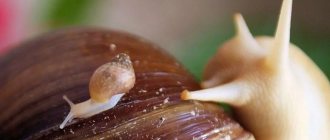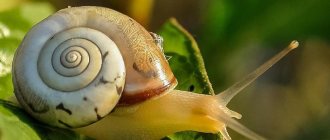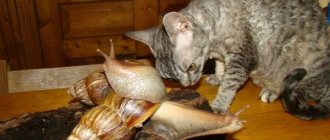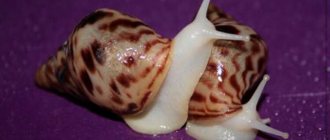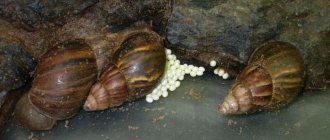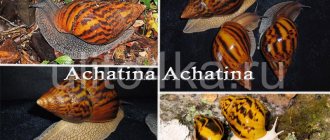Achatina, like all snails, is a hermaphrodite and, thanks to this feature, is very prolific; one individual can lay up to 1,000,000 eggs in a year. Of course, not at once, this is about 2-3 clutches per month. Usually, at home, breeders keep not one, but two or even several snails, which increases the likelihood of offspring appearing several times. What to do if the Achatina snail has laid eggs and how to detect the clutch in time?
To reproduce, Achatina needs favorable conditions:
- appropriate age – more than 6 months
- presence of a sexually mature partner
- proper and varied nutrition
- optimal temperature and humidity in the terrarium
Features of breeding Achatina: what you need to know
Before you decide to breed Achatina at home, you need to know about the intricacies of the snail’s body, as well as the possible consequences of reproduction. It is important not only to get the long-awaited Achatina snail eggs, but also to properly arrange the terrarium, choose a pair of parents and have detailed information on how to care for the eggs, otherwise the small mollusks will die before they are born.
Features and difficulties of breeding Achatina snails:
- Pregnancy has a negative impact on your pet’s well-being: after the snails have laid their eggs, the growth of the mollusks slows down significantly, and sometimes stops altogether. Therefore, it is recommended to mate only adult individuals at least one year old, since until this moment Achatina is actively growing.
- After laying snail eggs, the parent often experiences problems with the shell: the protective covering begins to crack or peel, which gives the pet an emaciated and sick appearance. The fact is that during childbirth, babies take a lot of calcium from the body of the mollusk, which is necessary to maintain the strength and integrity of the shell.
- African mollusks are known for their fertility, so you should be prepared for the fact that Achatina lays several hundred eggs at a time. Not every owner of an exotic pet is capable of keeping and feeding such a number of snails.
- After pregnancy, many young and miniature snails in the growing stage hibernate.
What stimulates a snail to lay eggs?
- onset of puberty;
- suitable partner;
- a nutritious and varied diet;
- maintaining optimal temperature and humidity in the terrarium;
- complete replacement of the soil with a new one.
The African snail is kept in a terrarium, aquarium or plastic container with transparent walls. Thus, detecting Achatina eggs will not be difficult. Snail breeders often find a clutch of mollusks at the bottom of the container. Take note of this and once a week lift the container up and inspect its bottom.
Look at the photo how clearly the masonry is visible at the bottom of my terrarium.
Since the African snail is an “exotic guest”, it cannot live in our harsh climate. Yes, and placing small snails is always a difficult and troublesome task. Therefore, it is better to freeze the Achatina clutch in the freezer for several days.
Reproduction of Achatina at home
African Achatina (regardless of the species: achatina iredalei, achatina reticulata, achatina fulica, etc.) are hermaphrodites, that is, they combine both male and female principles, but they need a pair to reproduce. Self-fertilization rarely occurs, so there is no need to worry that a lonely Achatina will suddenly begin to give birth. The larger and more resilient individual becomes the female in a pair of future parents, because pregnancy is a complex process that takes a lot of effort from the mollusk. However, there may be cases when both Achatina from a pair brought offspring at once.
In the Achatina snail, reproduction is possible from 6–8 months of life, however, snail experts recommend mating only those mollusks that have reached one year, since up to this point the pet is growing and developing. The genital organ is located on the neck and looks like a tubercle or depression of a light cream color. Its appearance signals that the pet is ready to reproduce.
How to make caviar from snail eggs
In France, snail eggs are considered a delicacy, served in the best restaurants. But every snail breeder can try to make caviar from eggs themselves.
- The required number of eggs is removed from the soil and washed well under running water.
- Then you should boil 1 liter of water and dissolve 100 grams of salt in it.
- After partial cooling (to +70C - +80C) of the solution, pour in the eggs and leave for 3 hours.
- The water is drained through a sieve, and the finished caviar, without any remaining moisture, is transferred to a jar, tightly closed and stored in the refrigerator for 3 months.
You can increase the shelf life of caviar from snail eggs by freezing it or adding a small amount of refined oil.
4.5 / 5 ( 8 votes)
Egg care
Achatina snail eggs are white and oval in shape, surrounded by a calcium layer. The number of testicles increases each time, and the first clutch may be small. You cannot touch the clutch with your hands, otherwise the mollusks will die, but you can carefully lay the eggs with a spoon if they are scattered on the ground. Not all eggs will be viable, and some of the eggs laid will be empty. The soil under the masonry should be moderately moist and the temperature should be 28C. If the number of eggs exceeds expectations, some are frozen or boiled to destroy them.
After the tiny Achatina hatches, they remain under the substrate, and only after a couple of days do they crawl out into the light. The baby eats the shell. There is no need to resettle baby and adult mollusks, as snails are friendly towards their offspring. However, as soon as the descendants reach sexual maturity, the pets will still have to be seated, so as not to get a new portion of babies.
Achatina snails easily and willingly reproduce at home, and caring for eggs and pregnant snails is not at all difficult. However, having decided to breed shellfish, you should carefully monitor the health of your pets and the number of eggs, because snails can quickly fill the entire terrarium. With proper care, you can achieve a long life expectancy.
Actions to eliminate masonry
The question of what to do if a snail has laid eggs is most often asked by inexperienced snail keepers. Most often we are talking about Achatina.
- If this happens, the first thing you need to do is not panic.
- Using a tablespoon, remove all the eggs from the soil and place them in a plastic bag.
- After this, tie the bag tightly and put it in the freezer for a day.
- Then throw all the contents into the trash bin along with the bag. It is imperative to freeze eggs. So that hatched mollusks do not begin to reproduce in the wild.
In some countries, Achatina eggs are considered a delicacy (snail caviar). In addition, after freezing, they can be dried and used as food for adult individuals.
Preparation for reproduction
For proper reproduction, certain conditions are created; it is recommended to prepare them in advance:
the volume of the terrarium is at least 15 liters; temperature +27, +28 degrees, a very important condition, since it will be difficult to get pets with other indicators; put wet soil on the bottom. The optimal soil thickness is 10 cm; provide calcium during procreation and after the process; clean the terrarium.. If fertilization is successful, they carry eggs for about 6 weeks, form holes in the ground and hide future offspring in them
If fertilization is successful, they carry eggs for about 6 weeks, form holes in the ground and hide future offspring in them.
It is recommended to touch the clutch of Achatina eggs with your hands only in emergency cases, for example, when the eggs are not in a hole, but spread out around the terrarium. The heat of the hands harms them.
Achatina also lays false eggs. They can be recognized by their color (translucent) and the absence of a shell.
A balanced diet is very important during pregnancy and after laying, as during this time a lot of strength, energy and nutrients are spent. It is advisable to add supplements with vitamins
There are viviparous Achatina. This species does not lay eggs, but gives birth to newborns through natural birth.
Health, disease and prevention
A number of factors influence the health of a snail, such as:
- Maintenance problems associated with hypothermia or overheating of shellfish. Confinement in cramped housing, using either dry or too wet soil.
- Nutritional problems when shellfish are fed low-calorie foods that contain insufficient amounts of protein and calcium.
- Problems with living conditions associated with unsanitary conditions.
- Poor ventilation and poor quality soil.
- Neighborhood problems when the compatibility of different species is not taken into account.
If a pet refuses food completely or partially, becomes lethargic, becomes clogged in the shell, and various discharges in the form of thick mucus are observed, then this is the first sign that the snail is sick. The disease is also indicated by delamination of the shell. The most dangerous disease is when a gastropod falls out of its shell. Such consequences may be associated either with genetic predispositions or as a result of prolonged exposure to chemically harmful components, bacteria, infections or fungi.
As a rule, in this case the mollusk quickly dies. To protect yourself and your pet from negative processes, you should approach dietary choices wisely.
In case of careless handling of the snail, damage of varying severity may occur, compromising the integrity of the shell. Some damage to the shell can be removed with epoxy glue, but in any case the animal must be provided with food rich in calcium
If you keep a snail in unsanitary conditions, it may develop parasites or infectious diseases, which require enormous effort to get rid of. To combat such phenomena, propolis-based ointments are used, as well as the drug “Mikoseptin” and iodine solution, which can be purchased at the pharmacy.
Types of eggs
A clutch may contain several types of eggs.
- A normal fertilized egg (most of them) with a snail embryo has a dense shell. Its color varies from white to yellowish.
- A fat egg is more like a translucent egg with jelly-like contents. Instead of a shell, it has a thin film. And by its purpose it is a nutrient for future small snails. The number of fat eggs in one clutch usually does not exceed 1 - 2 pieces.
- An unfertilized egg looks like a normal egg, but there is no embryo inside. Most often they are laid by Achatina, who lives alone, without a partner. The number of false eggs does not exceed 10 pieces. for Achatina and 1 - 2 pcs. for archahatina. If a mollusk has a pair, its next clutch will be full.
Snail mating games and mating
Despite the fact that all land-dwelling snails are hermaphrodites, in order for mating to be successful, they need a partner from another clutch. That is, it must be the same species, but belong to a different genetic line. If a snail is crossed with a representative of its own line, then their offspring may have various defects of varying degrees of severity. For example, this could be some kind of distortion or reduction in the shell, one-eyedness, low vitality, and the like.
Love dances of snails.
Snails must be proportional, full-fledged, beautiful, with the best qualities, for example, good size, rich color, correct shell shape, and so on.
Snails breed all year round, but only once. Moreover, most often they do this in the spring. It should be noted that if the weather is more humid, the number of newborn snails will be higher. When, during the mating season, two gastropods find each other, the courtship stage begins. At first, they only slightly touch each other with their tentacles, preferring to simply circle around each other.
After this, some types of snails, for example, grape snails, connect to each other with the soles of their bodies and moisturize each other with their mucus, which they secrete in large quantities.
The genital organs of the snail are located on the head.
They need this so that they do not become separated during mating. And only after this the snails begin to touch their copulatory organs. Mating continues for quite a long time, since the snails mate as leisurely as they move in space. After they stick to each other, the snails can spend the whole night motionless.
Some species of snails, such as Limicolaria, Archachatina and Achatina, mate in a slightly different position. It looks like this: one snail climbs onto the shell of another snail and if she reciprocates, then she shows it to her by tilting her head back - in the direction of the partner who climbed onto her back. After this, the snails touch each other with their genital pores.
After fertilization is complete and they exchange their spermatophores, which contain sperm, the snails quietly disperse in different directions. It must be said that gastropods have the ability to carry spermatophores in their bodies without laying eggs for a whole year.
Snails usually lay eggs in large clutches, enclosed in special egg capsules.
But in most cases, as a result of fertilization, an egg capsule is formed in one of the parents or both at once, which is a container with eggs covered with a durable transparent shell. When the time comes for laying, the shell with which it is covered either falls off or dissolves.
Useful properties of snails
Let us immediately reassure representatives of the fair sex who are prone to allergic reactions: the mucus of Achatina snails is hypoallergenic, and therefore it can be safely used by everyone, without exception.
So, speaking about the beneficial properties of Achatin mucin, one cannot fail to notice first of all that this composition is capable of rejuvenating the skin of the face. At the same time, expression and age wrinkles are reduced and smoothed out, the skin is regenerated and moisturized. Achatina mucus can reduce even dense scars, heal wounds, relieve various skin diseases and lighten age spots.
Snail mucin has antibacterial properties and is widely used in the fight against psoriasis, varicose veins, bronchitis and upper respiratory tract diseases. Mucus applied to the sore spot helps relieve pain.
Other beneficial properties of snail mucus in cosmetology:
- promotes tissue regeneration after burns;
- affects acne, stretch marks and scars;
- softens and heals the skin;
- cleanses the skin of dead cells;
- tightens pores;
- prevents the development of inflammatory processes;
- has antioxidant and antibacterial properties;
- gets rid of warts.
The meat of Achatina snails is also eaten. This diet helps improve the functioning of the gastrointestinal tract, helps with stress and normalizes the functioning of the central nervous system.
Shellfish cells are included in many drugs created to combat various serious diseases, such as Parkinson's disease and epilepsy. Snail mucus is widely used in the creation of cosmetic products.
Reproduction process
Reproduction in snails is an almost continuous process. Those who have been breeding them have noticed that in a short period of time, the aquarium is simply filled with mollusks. In order not to reach a critical indicator, this process must be controlled.
To make snails comfortable, they need an aquarium of more than 30 liters. The water must be settled. At first, no more than 4 individuals are introduced into the aquarium. They should be fed once every 1-2 days. The following is used as feed:
- boiled vegetables;
- fish food;
- a small amount of bread.
Snails come into the aquarium from pet stores, as well as with purchased plants and stones. They have caviar on them, which is hard to notice. Thus, settlement can occur without the knowledge of the aquarist. Therefore, it is recommended to pre-treat all decorative elements with special solutions. Coils and physes multiply at high speed. With their secretions they can ruin the habitat for fish.
You should not overfeed your fish. Excess food will be eaten by baby mollusks, which will further accelerate their reproduction.
